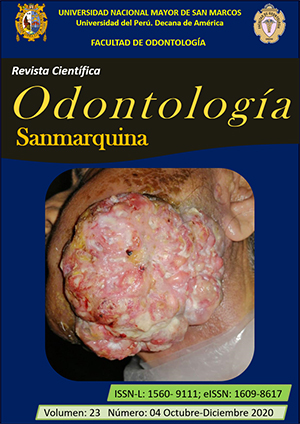Traumatic mental neuroma. Clinical case report
DOI:
https://doi.org/10.15381/os.v23i4.17441Keywords:
Neuroma, Trauma, Lip, (source: MeSH NLM)Abstract
Traumatic neuroma is not a true neoplasm but rather a reactive proliferation of neural tissue after transection or other damage to a nerve bundle. They can develop anywhere but are most common in the area of the mental foramen, tongue, and lower lip. Traumatic neuroma formation is a major cause of neuropathic pain, which remains a difficult problem for surgeons. The exact mechanism of the pain associated with the neuroma is still not fully understood and the prevention of its formation is essential to avoid it. To date the most effective treatment has been surgical removal. We report the case of a 23-year-old female patient who presented an increase in the volume of the vestibular sulcus at the level of teeth 44 and 45, as well as spontaneous burning pain with an evolution of approximately five months. It was decided to perform the surgical resection of the lesion and the histopathological result was a traumatic neuroma. At 7 days of follow-up, slight edema is observed in the oral and mental region; as well as anesthesia at the level of the skin of the chin and lower lip. A 10-month follow-up anesthesia persisted, and no recurrence data were observed.
Downloads
Downloads
Published
Issue
Section
License
Copyright (c) 2020 Oskar Eduardo Prada Vidarte, Alejandro Alonso Moctezuma, José de Jesús Ramos Nieto, Roberto Onner Cruz Tapia

This work is licensed under a Creative Commons Attribution-NonCommercial-ShareAlike 4.0 International License.
AUTHORS RETAIN THEIR RIGHTS:
a. Authors retain their trade mark rights and patent, and also on any process or procedure described in the article.
b. Authors retain their right to share, copy, distribute, perform and publicly communicate their article (eg, to place their article in an institutional repository or publish it in a book), with an acknowledgment of its initial publication in the Odontología Sanmarquina.
c. Authors retain theirs right to make a subsequent publication of their work, to use the article or any part thereof (eg a compilation of his papers, lecture notes, thesis, or a book), always indicating the source of publication (the originator of the work, journal, volume, number and date).






